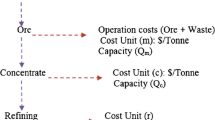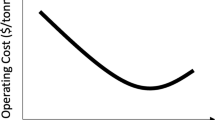Abstract
The cutoff grade of valuable components delimits the complex ore reserves suitable for efficient mining. The cutoff grade optimization is conducted to maximize the net present value of products in mining projects. The investigations were realized by using the equivalent grade method, iterated grid search method, genetic algorithm, and golden section search. The software presented ensures the calculation of the optimal production with melting considered and the cutoff grades over the life of mine.
Similar content being viewed by others
REFERENCES
A. E. Annels, Mineral Deposit Evaluation — a Partial Approach, Chapman & Hall, London (1991).
B. K. Barid and P. C. Satchwell, “Application of economic parameters and cutoffs during and after pit optimization,” Mining Engineering, February (2001).
S. Broder, “Cutoff grades — selection and influence and practical exercises,” Mine Geology and Grade Control, Nos. 7–11, University of New South Wales (1998).
P. Diehl and M. David, “Classification of ore reserves/resources based on geostatistical methods,” CIM Bulletin, 75 (1982).
P. A. Dowd and C. Xu, “The financial evaluation of polymetallic mining projects,” in: Proceedings of the 28th International Symposium on Application of Computers and Mathematics in the Mineral Industries, K. Dagdalen (ed.) (1999).
K. F. Lane, The Economic Definition of Ore — Cutoff Grades in Theory and Practice, Mining Journal Books Limited, London (1988).
J. Liimatainen, “Valuation model and equivalence factors for base metal ores,” in: Proceedings of Mine Planning and Equipment Selection, J. Singhal (ed.), Balkema, Rotterdam (1998).
M. Staples, “Whittle the muppets,” in: Proceedings of Optimizing with Whittle Conference (1995).
C. L. Wharton, “What they don't teach you in mining school tips and tricks with pit,” Surface Mining, South African Institute of Mining and Metallurgy, Johannesburg (1996).
S. Zhang, “Multimetal recoverable reserve estimation and its impact on the cove ultimate pit design,” Mining Engineering (1998).
A. J. Wheeler and R. L. Rodrigues, “Cutoff-grade analysis at Fazenda Brasileiro: mine planning for declining golden prices,” Trans. Instn. Min. Metall., Sect. A: Min. Technol., January–April (2002).
R. L. Rardin, Optimization in Operations Research, Prentice-Hall International, Inc. (1998).
J. Kim, “Iterated grid search algorithm on unimodal criteria,” Ph.D. Dissertation in Statistics, Blacksburg, Virginia (1997).
M. Gen and R. Cheng, Genetic Algorithms and Engineering Optimization, John Wiley & Son, Inc. (2000).
Z. Michalewicz, Genetic Algorithms + Data Structures = Evolution Programs, Springer-Verlag, Berlin-Heidelberg-New York (1996).
Author information
Authors and Affiliations
Rights and permissions
About this article
Cite this article
Ataei, M., Osanloo, M. Methods for Calculation of Optimal Cutoff Grades in Complex Ore Deposits. Journal of Mining Science 39, 499–507 (2003). https://doi.org/10.1023/B:JOMI.0000029314.42174.d9
Issue Date:
DOI: https://doi.org/10.1023/B:JOMI.0000029314.42174.d9




